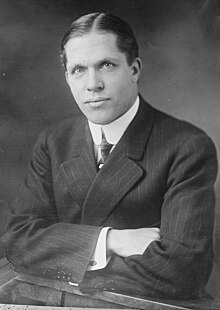|
Charles Piez
Charles Piez (September 24, 1866 - October 2, 1933) was an American mechanical engineer, manufacturer, and president of the Link-Belt Co.[1] He was president of the Electric Company, and vice president and general manager of the Emergency Fleet Corporation (EFC).[2][3] He is also known as president of the American Society of Mechanical Engineers from 1930 to 1931.[4] BiographyPiez was born in Mainz, Grand Duchy of Hesse, the son of Jacob Piez and Katherine (Liebig) Piez, both naturalized American citizens.[5] He emigrated with his parents to the United States, and attended public schools in Manhattan, New York City.[6] He entered the School of Mines of Columbia University in the class of 1888. Due to financial reverses in the family he worked for a year, and graduated with the class of 1889.[7] After graduation Piez started his career in industry as an engineer draftsman at the Link-Belt Engineering Corporation in Philadelphia[6] under James Mapes Dodge. He worked his way up to chief engineer, general manager, and eventually vice-president until 1906. In 1906, the Link-Belt Engineering Corporation merged into the Link-Belt Co., and Piez was elected president.[6] Piez held the position of president until 1917.[8] After the outbreak of World War I, Piez was appointed vice-president of the Emergency Fleet Corporation (EFC).[9] He represented the EFC on the priorities board of the War Industries Board.[10][11] In 1917, he was also appointed manager of the United States Shipping Board, succeeding Rear-Admiral Frederic R. Harris.[9] In 1919, Piez forbade the Seattle ship manufacturers from meeting workers demands, triggering the Seattle General Strike. Piez was singled out as a prime target of the strike. The action was unsuccessful.[12] Until his retirement in April 1933, Piez served as chairman of the board of the Link-Belt Corporation.[6] In 1925-1927, Piez served as President of the Illinois Manufacturers' Association.[13] From 1930 to 1931, he served as president of the American Society of Mechanical Engineers.[14] He died on October 2, 1933, in Washington, D.C.[1] Selected publications
References
External links
|
||||||||||||||||||
